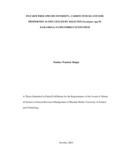ON-FARM TREE SPECIES DIVERSITY, CARBON STOCKS AND SOIL PROPERTIES AS INFLUENCED BY SELECTED Eucalyptus spp IN KAKAMEGA-NANDI FOREST ECOSYSTEM
Abstract
On-farm growing of trees has significantly contributed to easing pressure from natural
forests in addition to providing extra income to forest-adjoining farming households. There
are however concerns that Eucalyptus species is becoming the dominant trees in this
landscape and may have adverse effects on the environment. This study sought to
determine the effects Eucalyptus species on the on-farm woody species diversity, carbon
stocks and soil properties on farmlands located in the margins of the Kakamega - Nandi
Forest Ecosystem. The study targeted farmlands located 0 – 3 km from the forest boundary.
It employed a nested experimental design in which the study area was divided into three
sentinel blocks. Each block had three sub-blocks, namely: Shamiloli, Mukulusu and Lukala
in Kakamega; Makuchi, Makhanga and Blukhombe in Vihiga; and Cheboite, Burende and
Mukoyuro in South Nandi. Each sub-block comprised three types of trees stands namely:
Eucalyptus dominated tree stands, mixed tree stands comprising of Eucalyptus, indigenous
and exotic trees, and pure indigenous tree stands. The study was carried out along three
line transects that traversed the three types of trees stands in each block from the forest
edge to farmlands. Stratified systematic sampling was used to assess the extent to which
the observed variation in the concentration of Eucalyptus trees affected the three variables
under investigation (tree species diversity, carbon stocks and soil properties). A sample
plot comprised a main plot of 20m by 10m plot for measuring trees with a diameter at
breast height (DBH) ≥ 10 cm, a sub-plot of 10m by 5m nested within the main plot for
measuring saplings and shrubs of DBH less than 10cm. Data was collected on tree species
type, stem DBH for trees, tree height, counts of trees, saplings and shrubs. Composite soil
samples were collected within the main plot for analysis of soil organic carbon and other
physico-chemical properties. The data was subjected to both exploratory and inferential
statistical analysis using R Gui Version 4.2.1. Woody species diversity, carbon stocks, and
soil properties were subjected to analysis of variance (ANOVA) at 5% significance level to
assess their variation with change in the concentration of Eucalyptus trees on-farm. Post
hoc tests were carried out to determine the source of variation among means using the
Ryan-Einot-Gabriel-Welsch Multiple Range Test (REGWQ) at 5% significance level. A
total of (N=51) species representing 26 families were recorded. Of these species, (n=8)
were encountered in the Eucalyptus dominated tree stands, (n=29) in mixed tree species
stands and (n=32) in indigenous tree species stands. Among the woody species, mature
trees constituted 48.6% while saplings and shrubs comprised 51.4%. Myrtaceae family
constituted 50.3% of the woody trees followed by moraceae family with 7.5%. Woody
species richness, evenness and diversity were significantly higher in mixed tree stands and
indigenous tree stands than in Eucalyptus dominated tree stands (p< 0.05). Trees in the
Eucalyptus dominated stands and mixed stands had significantly smaller stem diameter,
basal area and above ground biomass than in the adjacent indigenous trees stand (p< 0.05).
The highest amount of total carbon was observed in the indigenous trees stand. The
percentage soil organic carbon in the Eucalyptus dominated tree stands and mixed tree
stands was significantly lower than in the adjacent indigenous trees stands (p< 0.05). The
bulk density in the Eucalyptus dominated tree stands and mixed tree stands was
significantly higher than in the adjacent indigenous trees stands (p< 0.05). Phosphorus,
Nitrogen and potassium did not vary significantly within the three tree stands (p> 0.05).
The results suggest that a higher diversity of indigenous trees enhances aboveground
carbon stocks and promotes ecosystem conservation

